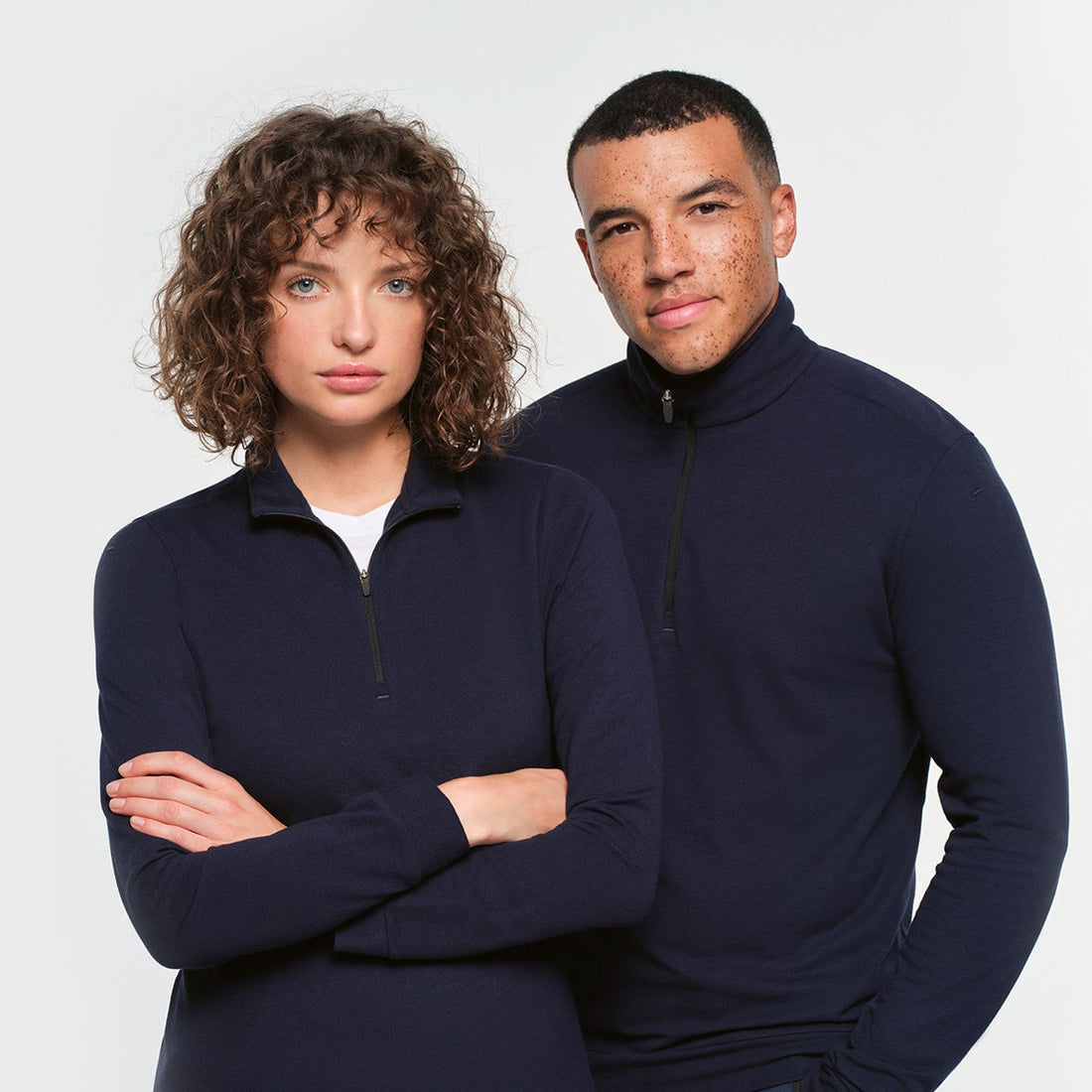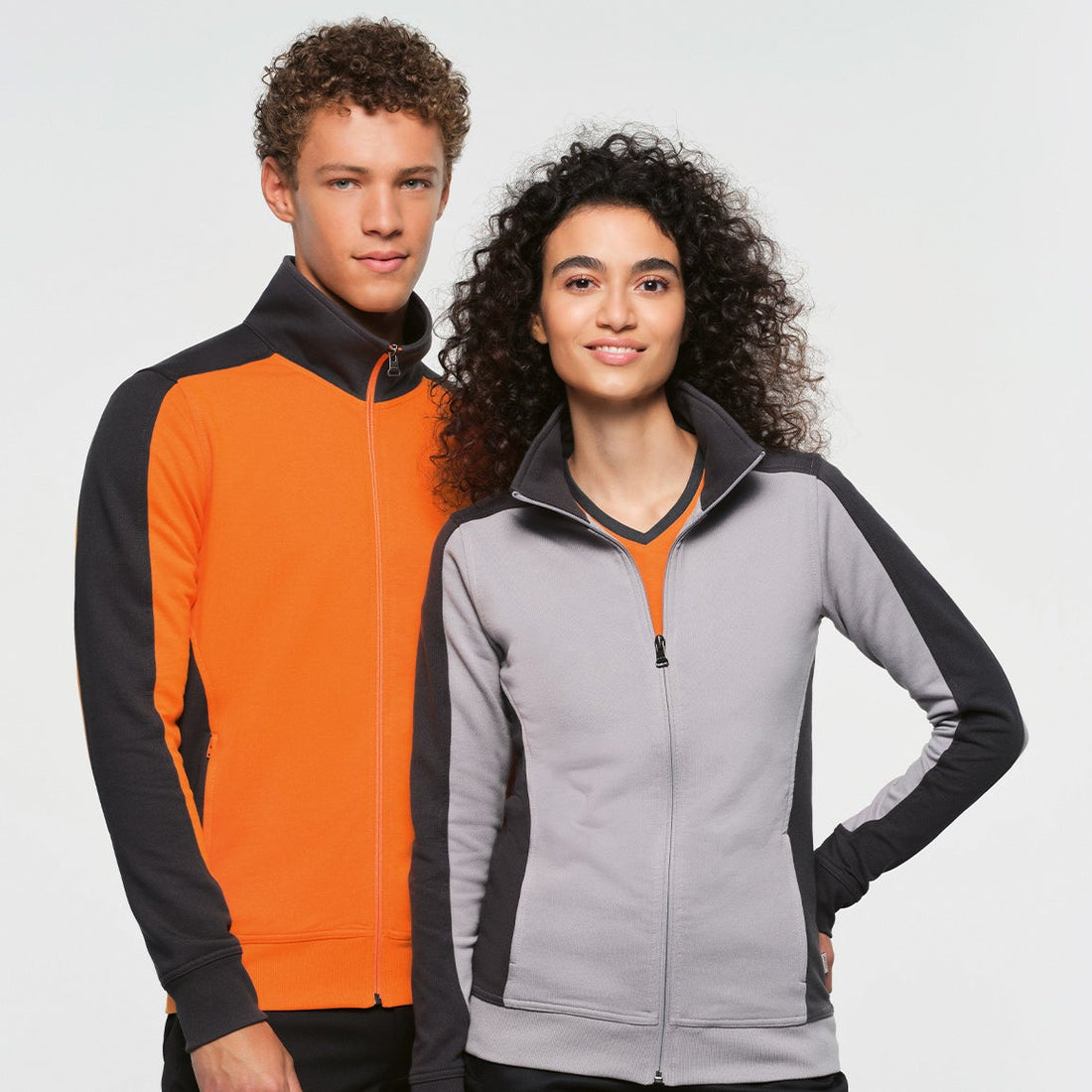Good to know.
Here you can find out what you should pay particular attention to when putting together your employee outfits, how workwear lasts even longer thanks to proper care and why a private label might be just the right thing for you.
Shelf life guide
Wash me, but don't break meClothes really wear out when they are washed incorrectly and dried too hot. For example, by using detergents containing bleach or overfilling the washing machine. Please pay particular attention to the line under the washing symbol. It stands for gentle wash cycle, which means that the machine should only be half loaded. This protects the laundry and makes it easier to rinse out dirt.The number in the centre of the wash symbol indicates the maximum temperature at which the item may be washed. However, thirty degrees or less is often sufficient for light soiling, as modern detergents are already active at very low temperatures. This is good for the environment and for the life of the laundry. Washing at 30°C instead of 60°C, for example, saves up to 40% electricity. That's why HAKRO supports the "THINK GREEN - WASH AT 30°C" initiative. Join in!Birds of a feather flock together. Before washing, sort your laundry according to material, texture and separately for light and dark colours. It's better to wash twice correctly than once incorrectly. It doesn't matter if the machine doesn't get completely full. Loose loading protects your laundry, extends the life of the textiles and is therefore very sustainable. Yes, it takes a bit more work. Nevertheless, you should turn all items of clothing inside out before washing. This will keep the surfaces of your textiles looking like new for much longer and protect delicate finishes. Please check the pockets and close all buttons and zips, then the washing process can begin. Educational facts about detergentsThey are called compact, universal or heavy-duty detergents and almost always contain bleaching agents or optical brighteners, which make light-coloured and white laundry made of pure cotton brightly clean, but are harmful to all coloured textiles (and also white textiles made of fibre blends or synthetics). You should therefore only use colour detergents for coloured textiles. Delicate fabrics are cleaned gently with mild detergents or wool or silk detergents. For the sake of your laundry, we recommend that you always use liquid detergents.For the sake of your laundry, you should follow the detergent manufacturer's dosage recommendations. Depending on the hardness of your tap water, exactly the right amount of detergent is recommended for light, medium and very heavily soiled textiles. Follow them exactly. Particularly difficult stains require additional treatment, as the strength of a detergent cannot be increased by overdosing. This only harms the textiles and the environment. Tricky dryingTake the laundry out of the machine as soon as possible after the spin cycle, shake out each item vigorously, pull it gently into shape and hang it on a line or clothes horse. T-shirts are best hung upside down with clips at the end of the side seams. Light shirts and blouses can be dried directly on hangers.If you use a tumble dryer, please ensure that you only dry similar textiles together and that the laundry is spun beforehand according to the care labelling. The tumble dryer drum must never be overloaded. To protect your textiles, we recommend using the "iron dry" setting. This prevents your laundry from being overdried and also protects it from creasing. After drying, leave to steam briefly on the line. The thing with stainsOne thing is certain: rubbing, rubbing and spreading does not remove the stain. On the contrary. Rubbing destroys the surface of the textiles and you work the substance that caused the stain deep into the fibres. The stain may be gone after the next wash, but the damage remains.Try to carefully dab the substance that caused the stain out of the garment. To do this, place a soft cloth under the affected area and press against the stain from above with a second soft cloth. Caution - do not rub! Both cloths gently absorb the stain substance. You can then repeat the procedure with a damp cloth. For stubborn stains on your favourite items, the professionals at your dry cleaner can also help.Before you treat the stain with home remedies or stain removers, we strongly recommend that you carry out a hem test, i.e. test the effects of the product on an inconspicuous area. Only then can you be sure that there will be no nasty surprises when you use the product. Always apply the product exactly according to the instructions on the packaging and do not allow it to dry out afterwards, but wash the item immediately. It is best to wash heavily soiled laundry immediately. Dried-in stains are much more difficult to wash out. Please remove coarse dirt such as soil and building materials beforehand. Damp laundry, such as sportswear, should also be put in the machine straight away, otherwise mould stains can form. The same applies to stains, carefully dab them out and put them in the washing machine so that red wine, gravy and carrot juice don't have time to set permanently on your clothes. Stain removal for advanced usersDurability is our strength, but even the best quality textiles are no match for alkaline or acidic solutions. Sweat, especially in combination with intensive UV radiation, can be really corrosive and damage or even dissolve the colour pigments in textiles, which can quickly lead to unsightly stains and discolouration. It is therefore best to always wash heavily sweaty clothing immediately. It should also go without saying that you should not wear the same work shirt for several days in a row.Most greasy stains on cotton or synthetic fabrics can be easily removed with cornflour or potato flour. Simply sprinkle evenly over the stain, leave to work, brush off and then wash as normal. Heavy machine oil can be removed by carefully rubbing the stain with soft butter before washing. Alternatively, you can use the special stain removers available on the market.Antiperspirant deodorants cause unsightly stains, especially on white textiles. It helps to soak the affected areas in water with lemon juice or in water with denture cleaner and then wash as normal. Here you cannot avoid special stain removers. Please use exactly according to the manufacturer's instructions. Older stains on cotton fabrics can be dabbed with nail varnish remover and then washed according to the washing instructions on the label. The same applies here: test the nail varnish remover on an inconspicuous area first.First remove the hardened wax from the fabric surface, then place the fabric between two double layers of kitchen paper. Now press a warm (not hot) iron onto the back of the fabric. The wax heats up, melts and is absorbed by the paper towel. Then wash the item in the washing machine.Water-soluble stains are no problem for today's detergents at low temperatures. However, some types of fruit and drinks contain colouring and tanning agents that can leave stubborn stains. Treat these with pure vinegar or lemon juice after testing the application on an inconspicuous area. Immediate soaking in cold water and carefully working in liquid gall soap have also proved very effective on fruit stains.
Learn moreGuide for customised products
Minimum quantityAs a rule, it only makes sense to think about customised production once you have around one hundred employees. This is when the so-called cost-benefit threshold is reached. Plan for additional demand from the outset, for example due to the recruitment of new employees or wear and tear, as small quantities cannot simply be reordered.DesignPrivate labels can give a brand, an association, an organisation or a municipality a completely independent appearance. Development takes place in close consultation with your HAKRO specialist retailer. They will advise you on the choice of materials, colours, cuts and finishes. The design itself is then created for you directly by the HAKRO specialist retailer or by us on a fee basis. As soon as the design has been approved by you, we calculate the quotation for production.ProductionYou can rely on our decades of experience in the production of high-quality textiles to manufacture your collection. We select the most suitable HAKRO production partners for the styles you require and calculate the production costs. We then sample the colours, cuts and finishes. If you would like to have any special accessories, such as buttons with laser engraving, special zips or your own labels, these are also developed and sampled at this stage. Sample collectionYou will receive the first production samples six to eight weeks after placing your order. These correspond to the original quality, including all processing details and all finishes. Only when you are satisfied with the quality and finish do we start production. This includes all HAKRO quality management checks and also includes a final inspection before delivery.Customised productsCustomised products for specific items from our existing range are simpler and usually much cheaper than developing a completely independent collection. This could be a special colour, a special label on the neck or side seam, an additional pocket or an individual finished size chart. These individual versions of existing models can be realised quickly and flexibly.
Learn moreShopping guide
The better your specialist dealer knows what you need, the more accurately he can supply it to you. And the more satisfied you will be with our products afterwards. So take the time to think carefully about what you want beforehand.
Learn more

